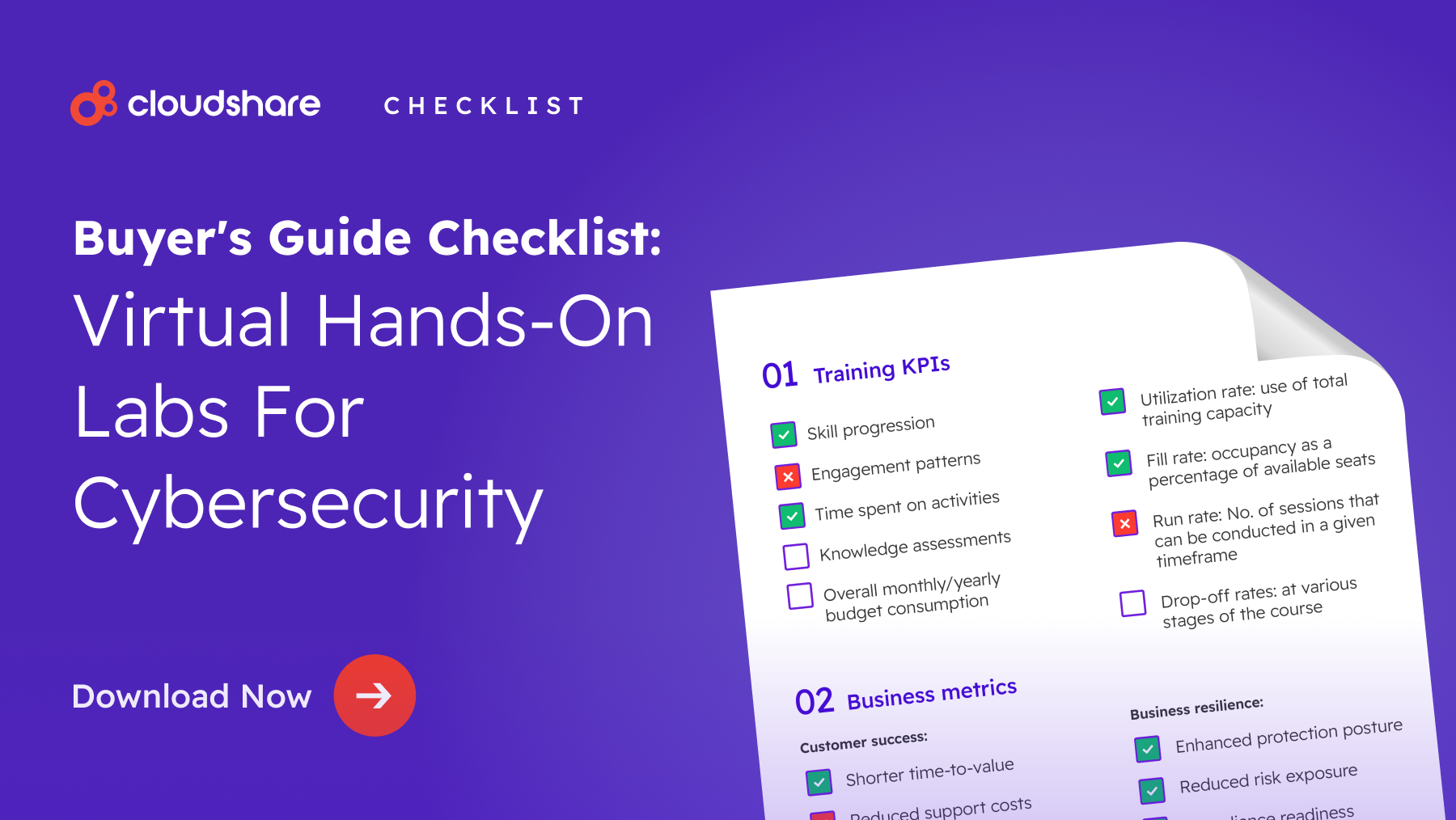
One of the first steps in creating an effective virtual training program is to define your key performance indicators (KPIs). This holds true regardless of whether your training is customer-focused or internal. As a training manager, learning and development metrics help you both optimize your training and convey that training’s value to leadership.
What is a Training KPI?
A key performance indicator (KPI) is any metric used to assess the effectiveness of a strategy, program, or initiative. In the context of software training, this typically involves measuring the knowledge and performance of users who have completed a course. In addition to results, training KPIs also assess the training process itself, with the goal of identifying potential weaknesses or bottlenecks.
The Importance of Measuring Training Metrics
Corporate training, no matter its target audience, is a data-driven process. Without analytics, you have no real way of identifying whether or not a training program was successful. You also cannot demonstrate the value of your training to organizational leadership.
Training metrics also have a direct impact on the training process itself, as managers can use data to proactively identify users that require assistance or intervention. This in turn has a knock-on effect on ROI, as it allows managers to achieve better results in both the short-term and long-term.
How to Measure the Success of Learning and Development: Key KPIs
Your training program’s core audience and objectives will largely determine which metrics you should track. We’ve compiled a few common employee training KPI examples below to help get you started — and explained why each one is relevant.
Training attendance rate
Your training attendance rate is calculated by comparing the attendees in each course or session to overall signups. Attendance rate can also be calculated on a participant-by-participant basis.
A low training attendance rate could point to a few possible issues. There might be technical problems with your training that prevent people from accessing it. People might be forgetting about your training because they’re not receiving any reminders.
Finally, there’s a chance that your training simply isn’t relevant to your audience.
Average time to completion
Measures how long it generally takes users to complete your training. An overly long time to completion may be indicative of problems with delivery, content, or engagement. On the other hand, an incredibly short completion time could indicate that your training content lacks substance.
Course completion rate
Calculated by measuring the total attendees in a course against the number of attendees that completed said course. A low course completion rate usually means there’s something wrong with either your training content or the overall user experience. Start by looking at where most participants tend to drop out — that’s your quit point, and the problem is most likely somewhere around there.
Engagement score
Calculated through a combination of exit interviews, user feedback, and learner retention rate. This metric provides an overall view of how compelling your training and its content are to learners. Combined with data from user surveys, it can also provide you with insights on how you might improve your training.
Return on Investment (ROI)
Demonstrates how well your training program has delivered on its training objective with regard to how much your business invested in it. This metric is highly dependent on your organization’s desired outcomes. Potential ROI metrics could include sales numbers, productivity, customer satisfaction, employee satisfaction, etc.
Learner satisfaction
Measures how your users feel about your training program. Calculated similarly to engagement score, learner satisfaction serves a similar purpose, giving you an overview of your training’s overall user experience. You can also use learner satisfaction to gauge whether participants feel your training is focusing on what’s actually important to participants.
Learner retention
Measures how well your training conveys the knowledge it’s meant to convey. Typically calculated through post-training assessments or quizzes. May also be tracked by monitoring the volume of helpdesk/support calls.
Job performance metrics
Measures your training’s overall impact on job performance. These metrics can take a ton of different forms depending on both the participants and the nature of your training content. The basic idea is to answer the question of whether employees who’ve completed your training perform better than those who haven’t.
Some potential examples include:
- Sales numbers.
- Helpdesk resolutions.
- Project completion rate.
- Productivity over time.
- Pass/fail rate for specific workplace activities.
- Average deal size.
- Customer satisfaction score.
- Internal software utilization.
Remember that none of these metrics exist in a vacuum. Contextualize them alongside other metrics, otherwise you’ll be giving yourself an incomplete picture.
Customer onboarding time
Measures how long it takes a customer to begin using your software after signing up/finalizing a purchase. Ideally, you want this number to be as small as possible — though not so small that a customer doesn’t have time to actually learn how your product works. An overly long onboarding time could mean there are issues with the hand-off between sales and customer success or problems with your customer education.
Time to first value
Measures how long it takes a customer to realize that your software addresses their needs and/or helps them fulfill their business objectives. The lower this metric is, the better. Ideally, you want time to first value to be more or less in-sync with onboarding time.
Product adoption rate
Calculated by comparing new active users against total sign-ups. This metric is incredibly helpful for identifying bottlenecks in your customer onboarding process.
Product usage frequency
Helps measure the stickiness of your product alongside customer satisfaction. Also provides your sales team with insight into who they can upsell or cross-sell to.
Product usage depth
Identifies customers that are using advanced features of your software and gives insight into the extent that customers are exploring your software’s capabilities.
Keep Track of Your Core Training KPIs with CloudShare
Whether you’re onboarding new customers, training new employees, or offering professional development to existing staff, learning and development metrics are crucial to your success. They not only help you identify shortcomings and weaknesses in your training, but also allow you to convey the value of your training to other departments. Moreover, the right KPIs also provide insight into your best trainees.
For customer training, that means more up-sell and cross-sell opportunities. For employee training, that means finding and recognizing potential leaders and mentors. In either case, it’s not an opportunity you can afford to overlook.
And with CloudShare, you won’t have to worry about doing so. Our virtual training platform is equipped with powerful, comprehensive analytics tools that allow you to monitor everything from user behavior to resource utilization. Intuitive, customizable reporting functionality, meanwhile, ensures that you’ll never have to worry about how you’ll convey ROI to leadership.
FAQs
1. How do you identify the right KPIs for training programs?
Identifying the right KPIs for training programs involves aligning your metrics with the specific goals and objectives of your training initiative. Start by determining the core purpose of the training, whether it’s to improve employee performance, enhance customer onboarding, or increase product adoption. From there, choose KPIs that directly measure these objectives, such as:
- Course Completion Rates: Measures how many learners finish the course, indicating the effectiveness and engagement of the training program.
- Learner Satisfaction: Gauges how satisfied participants are with the training, often measured through surveys or feedback forms.
- Knowledge Retention: Assesses how well learners retain the information taught, typically through assessments or quizzes.
In addition to these core metrics, consider tracking user engagement metrics, such as:
- Dropoff Rates: Identifies where learners are leaving the course, providing insights into potential areas of improvement.
- Participation Rates: Measures the level of interaction and involvement in the training activities.
- Time to Completion: Tracks how long it takes learners to complete the course, which can indicate the course’s complexity or engagement level.
By focusing on these KPIs, you can create a comprehensive evaluation framework that not only measures the effectiveness of the training content but also its impact on business outcomes. This helps in demonstrating the training’s value to leadership and ensures continuous improvement of the training programs.
2. How can technology impact the effectiveness of Training KPIs?
Technology significantly enhances the effectiveness of Training KPIs by providing advanced tools for data collection, analysis, and reporting. Virtual IT Labs, for instance, offer hands-on, practical training environments that enable real-time tracking of learner engagement and performance, providing detailed insights that manual methods cannot match. Automated assessments and analytics tools streamline the measurement of key metrics such as completion rates, time to competency, and learner satisfaction, ensuring accurate and timely data.
Additionally, technology facilitates personalized learning experiences by adapting training content to individual needs and pace, thereby improving engagement and retention. By leveraging these technological capabilities, organizations can more effectively monitor, analyze, and optimize their training programs, leading to more informed decisions and better outcomes.
3. How do you monitor and adjust Training KPIs over time?
Monitoring and adjusting Training KPIs over time involves a continuous cycle of data collection, analysis, and refinement. Begin by consistently tracking key metrics using advanced analytics tools that provide real-time insights into learner performance, engagement, and satisfaction. Regularly review these metrics to identify trends, successes, and areas needing improvement. Gather feedback from learners through surveys and assessments to gain qualitative insights into the training experience. Based on this data, make necessary adjustments to the training content, delivery methods, or learning platforms to address any identified gaps or inefficiencies. Establish periodic check-ins and reviews to ensure that the KPIs remain aligned with evolving organizational goals and learner needs. By adopting a proactive and iterative approach, you can ensure that your training programs remain effective and continue to deliver optimal results.
Book a demo today to see CloudShare in action.
This post was published in August 2023 and updated in August 2024




